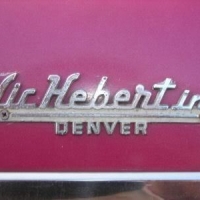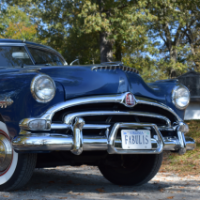Hornet cooling issues
dave11
Expert Adviser
With the hot temperatures we are seeing this summer in my neck of the woods BC Canada (32 + degrees celsius), the 308 in my 52 Hornet is struggling to stay cool, particularly on steep mountain passes.
Wondering what is the best practices for those Hudsons that live in the desert states?
I have the OEM radiator that has beed recored, engine is in good overall condition. I have installed a 6 blade fan as well as a 6 volt pusher fan on the front of the radiator, although it is doubtfull if the elect fan helps at all.
Has anyone tried installing a fan shroud, and if so did they adapt one or have one fabricated?
Dave Eddie
Wondering what is the best practices for those Hudsons that live in the desert states?
I have the OEM radiator that has beed recored, engine is in good overall condition. I have installed a 6 blade fan as well as a 6 volt pusher fan on the front of the radiator, although it is doubtfull if the elect fan helps at all.
Has anyone tried installing a fan shroud, and if so did they adapt one or have one fabricated?
Dave Eddie
0
Comments
-
It may take some doing but take measurements between the radiator and the fan. There are some shrouds out here for GM card or Dodge cars or Ford cars. Use this for a starting point. Also look for older junkyards with these older kinds of cars0
-
Make sure your radiator shields are in place.
below and on top of radiator mount frame.
Usually the lower one is gone, and the top one has a gap allowing air over the top.
You can make seals for the sides also.
The air has to go through the radiator , not around it.
I drove my 49 Hudson with stock radiator and fan set up in 104 degrees
at highway speeds and traffic, gauge was past 3/4 , but never spit up water.
0 -
Tks, all good advice
Dave0 -
The distance from the fan blades to the radiator is critical for good flow without a shroud. Consult the service manual for the clearance (it should be about 3/4"). This distance is adjusted by moving the radiator back and forth via its mounting brackets.0
-
I just bought, a new to me, Hudson Twin H. I wanted to know if there are pictures of the radiator shields?Are there photos available of the insulation that should be under the hood? The car has insulation and I do not have a reference to know if what is under the hood is correct.0
-
This link will show several items that will help. Scoops to get more air into radiator; tape{Gorilla Tape} over EVERY space between radiator and radiator support where air might escape w/o going thru radiator; get a good elect. fan w/control; get a water pump fan that has 6 blades, and space close to radiator. I have expensive aluminum radiator so I have rods on each engine side fastened to crossmember so engine cannot move forward. I did insulate under the hood but wish I hadn't since you do not want to hold the heat in the engine bay and that will do it; let it radiate from top of hood. My 2 cents.......
Also I have a temp sensor that reads in degrees F rather than the stock needle position.
Photos>>> https://photos.app.goo.gl/pZfDhYyfPB6t7XeN90 -
Wide-blade flex fans are an amazing improvement and aren't terribly anachronistic if you paint them. I had a ford product years ago with cooling issues. I put a high density core in the original radiator frame and added a Wide-blade 5 in it. Never needed to add a fan shroud.0
-
There are great suggestions here... I also suggest you read the attachment as captures the actions many different HET owners took trying to solve this same issue. Also note .... Hudson had contract foundry's manufacture their engine blocks. Sand casting was the method used to create the blocks... all blocks were "aged" outside before final machining was completed. Assuming Hudson cleaned the blocks thoroughly before machining would be a mistake! All of the engines I have rebuilt have had heavy buildup of casting sand in the water jackets... especially at the end of the block closest to the firewall. (Sand moves to the rear of the engine block as the engine is used). couple the sand with interior rust scale and it becomes very hard. These sand/rust groups create "hot spots" where they collect. The best thing one can do with an overheating engine after all other considerations have been inspected and corrected, is to remove the "freeze plugs - ie sand casting openings", the radiator, water-pump and water distribution tube. Use a high pressure washer to power wash the inside of the engine to clear the sand and rust. You will remove a lot of sand if this has not been previously accomplished.
A Shroud is another opportunity to improve the efficency of the radiator ... this is a link to a fellow HET owner who has accomplished this action using an available universal kit.
https://www.53hor.net/posts/2021-10-01-shroud-your-rad-for-an-ice-cold-hudson.php
Good Luck Ken Cates0 -
Thanks for the comments and link.Kim0
-
Thanks Ken for sharing the fan shroud mod. I am very proud of how cool my Hornet runs, without any electric fans. If any of you have any questions about the shroud feel free to PM me. We intend on fabricating one for OEM radiators and then having a local shop stamp them so they look a little less homebrew.0
-
Wondering what is the diameter of the OEM Hornet fan blade?
mine met a violent death after contacting the radiator core. I have since installed an 18 “ dia 6 blade fan, at the time the thinking was big is better, however the 18” fan is pretty close to the upper rad hose, not a lot of room for a shroud.
Dave Eddie0
Categories
- 36.9K All Categories
- 113 Hudson 1916 - 1929
- 20 Upcoming Events
- 92 Essex Super 6
- 28.6K HUDSON
- 574 "How To" - Skills, mechanical and other wise
- 995 Street Rods
- 151 American Motors
- 178 The Flathead Forum
- 49 Manuals, etc,.
- 78 Hudson 8
- 44 FORUM - Instructions and Tips on using the forum
- 2.8K CLASSIFIEDS
- 608 Vehicles
- 2.2K Parts & Pieces
- 77 Literature & Memorabilia
- Hudson 1916 - 1929 Yahoo Groups Archived Photos



